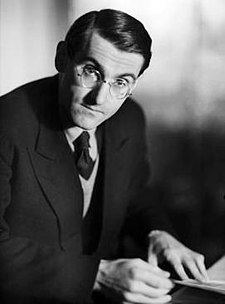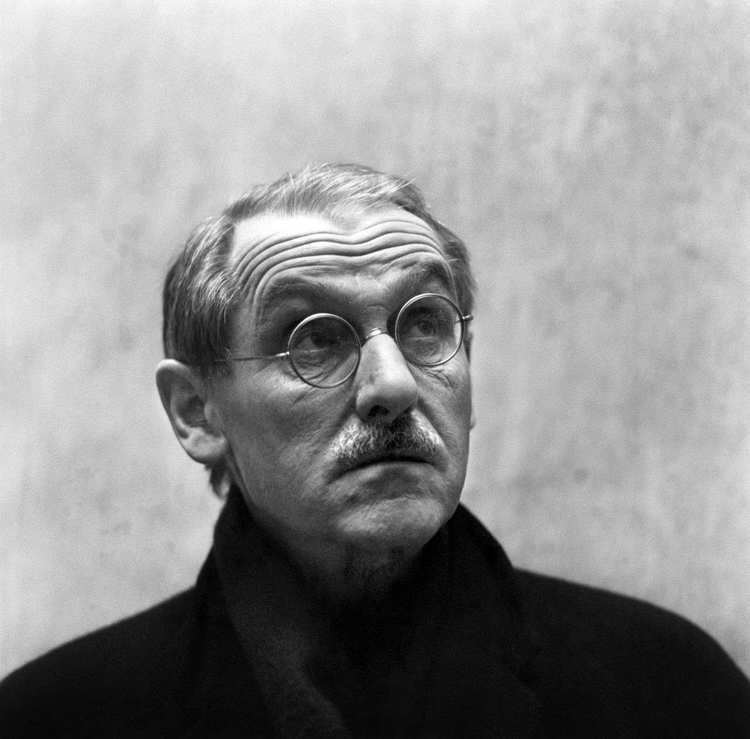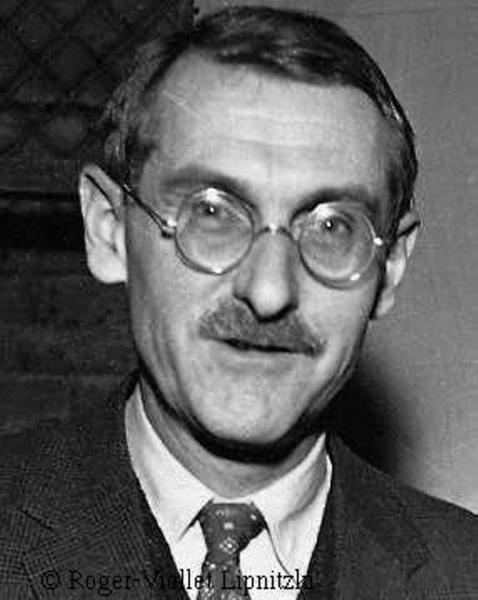Nationality French Role Dramatist Name Jean Anouilh | Literary movement Modernism Period Mid-20th century Spouse Nicole Anouilh (m. 1953) | |
 | ||
Born Jean Marie Lucien Pierre Anouilh23 June 1910Bordeaux, France ( 1910-06-23 ) Occupation Dramatist, Screenwriter Notable works The LarkBecketTraveler without LuggageAntigone Books Medee, La sauvage, Ardele ou la Marguerite Movies Becket, You Ain't Seen Nothin' Yet, Monsieur Vincent Plays Similar People Sophocles, Andre Barsacq, Jean Cocteau, Thomas Becket, Bertolt Brecht | ||
L ocadia jean anouilh
Jean Marie Lucien Pierre Anouilh ([ʒɑ̃ anuj]; 23 June 1910 – 3 October 1987) was a French dramatist whose career spanned five decades. Though his work ranged from high drama to absurdist farce, Anouilh is best known for his 1943 play Antigone, an adaptation of Sophocles' classical drama, that was seen as an attack on Marshal Pétain's Vichy government. One of France's most prolific writers after World War II, much of Anouilh's work deals with themes of maintaining integrity in a world of moral compromise.
Contents
- L ocadia jean anouilh
- La belle vie jean anouilh pi ce de th tre int grale version hfr hd
- Early life
- Theatre work
- Playwright
- Political controversy
- Awards and recognition
- Critical discussion
- Theatre productions
- Theatre productions in France
- Films
- Television
- Published plays
- English language anthologies
- Theory and criticism
- Translations by Anouilh
- Other publications
- References

La belle vie jean anouilh pi ce de th tre int grale version hfr hd
Early life

Anouilh was born in Cérisole, a small village on the outskirts of Bordeaux, and had Basque ancestry. His father, François Anouilh, was a tailor, and Anouilh maintained that he inherited from him a pride in conscientious craftmanship. He may owe his artistic bent to his mother, Marie-Magdeleine, a violinist who supplemented the family's meager income by playing summer seasons in the casino orchestra in the nearby seaside resort of Arcachon. Marie-Magdeleine worked the night shifts in the music-hall orchestras and sometimes accompanied stage presentations, affording Anouilh ample opportunity to absorb the dramatic performances from backstage. He often attended rehearsals and solicited the resident authors to let him read scripts until bedtime. He first tried his hand at playwriting here, at the age of 12, though his earliest works do not survive.

In 1918 the family moved to Paris where the young Anouilh received his secondary education at the Lycée Chaptal. Jean-Louis Barrault, later a major French director, was a pupil there at the same time and recalls Anouilh as an intense, rather dandified figure who hardly noticed a boy some two years younger than himself. He earned acceptance into the law school at the Sorbonne but, unable to support himself financially, he left after just 18 months to seek work as a copywriter at the advertising agency Publicité Damour. He liked the work, and spoke more than once with wry approval of the lessons in the classical virtues of brevity and precision of language he learned while drafting advertising copy.
Anouilh's financial troubles continued after he was called up to military service in 1929. Supported by only his meager conscription salary, Anouilh married the actress Monelle Valentin in 1931. Though she would go on to star in many of his plays, Anouilh's daughter Caroline (from his second marriage), claims that the marriage was not a happy one. Anouilh's youngest daughter Colombe even claims that there was never an official marriage between Anouilh and Valentin. She allegedly had multiple extramarital affairs, which caused Anouilh much pain and suffering. The infidelity weighed heavily on the dramatist as a result of the uncertainty about his own parentage. According to Caroline, Anouilh had learned that his mother had had a lover at the theatre in Arcachon who was actually his biological father. In spite of this, Anouilh and Valentin had a daughter, Catherine, in 1934 who would follow the pair into theatre work at an early age. Anouilh's growing family placed further strain on his already limited finances. Determined to break into writing full-time, he began to write comic scenes for the cinema to supplement their income.
Theatre work
At the age of 25, Anouilh found work as a secretary to the French actor and director Louis Jouvet at the Comédie des Champs-Elysées. Though Anouilh's boss had happily lent him some of the set furniture left over from the production of Jean Giraudoux's play Siegfried to furnish his modest home, the director was not interested in encouraging his assistant's attempts at playwriting. Jouvet had risen to fame in the early 1930s through his collaborations with the playwright Giraudoux, and together the two worked to shift focus from the authorial voice of the director (which had dominated the French stage since the early twentieth century) back to the playwright and his text.
Giraudoux was an inspiration to Anouilh and, with the encouragement of the acclaimed playwright, he began writing again in 1929. Before the end of the year he made his theatrical debut with Humulus le muet, a collaborative project with Jean Aurenche. It was followed by his first solo projects, L'Hermine (The Ermine) in 1932 and Mandarine in 1933, both produced by Aurélien Lugné-Poe, an innovative actor and stage manager who was then head of the Théâtre de l'Œuvre. Ruled by the philosophy, "the word creates the decor," Lugné-Poe let Anouilh's lyrical prose shine in front of a backdrop of simple compositions of line and color that created a unity of style and mood.
The plays were not great successes, closing after 37 and 13 performances respectively, but Anouilh persevered, following it up with a string of productions, most notably Y'avait un prisonnier (1935). These works, most in collaboration with the experimental Russian director Georges Pitoëff, were considered promising despite their lack of commercial profits, and the duo continued to work together until they had their first major success in 1937 with Le voyageur sans bagage (Traveller Without Luggage). In subsequent years, there was rarely a season in Paris that did not prominently feature a new Anouilh play and many of these were also being exported to England and America. After 1938, however, much of Anouilh's later work was directed by the prominent Paris scenic designer André Barsacq, who had taken over as director of the Théâtre de l'Atelier after Charles Dullin's retirement in 1940. Barsacq was a champion for Anouilh and their affiliation was a major factor in the playwright's continued success after the war.
Playwright
In the 1940s, Anouilh turned from contemporary tales to more mythical, classic, and historic subjects. With protagonists who asserted their independence from the fated past, themes during this period are more closely related to the existential concerns of such writers as Jean-Paul Sartre and Albert Camus. The most famous play of this group is Antigone, which "established Anouilh as a leading dramatist, not only because of the power with which he drew the classic confrontation between the uncompromising Antigone and the politically expedient Creon, but also because French theatre-goers under the occupation read the play as a contemporary political parable." His post-war plays dealt with similar concerns and included Roméo et Jeannette, Médée (Medea), and Anouilh's Joan of Arc story L'Alouette (The Lark), which, in its distinct optimism, rivalled the commercial success of Antigone.
Anouilh himself grouped his plays of this period on the basis of their dominant tone, publishing his later works in collected volumes to reflect what he felt "represented the phases of his evolution and loosely resembled the distinction between comedy and tragedy." Pièces noires or "Black plays" were tragedies or realistic dramas and included Antigone, Jézabel, and La Sauvage (The Restless Heart). This category typically featured "young, idealistic, and uncompromising protagonists [who] are able to maintain their integrity only by choosing death." By contrast, Anouilh's pièces roses or "pink plays" were comedies where fantasy dominated with an atmosphere similar to that of fairy tales. In these plays such as Le Bal des voleurs (Carnival of Thieves), Le Rendez-vous de Senlis (Dinner with the Family) and Léocadia (Time Remembered), the focus is on "the burden of the environment and especially of the past on a protagonist seeking a happier, freer existence."
Most of Anouilh's plays of the late 1940s and into the 1950s become darker and distinctly cruel and, in contrast with his earlier works, begin to feature middle-aged characters who must view life more practically than Anouilh's former idealistic youths. The playwright divided the works of this period into pièces brillantes ("brilliant plays") and pièces grinçantes ("grating plays"). The first group includes works such as L'Invitation au château (Ring Round the Moon) and Colombe, and are typified by aristocratic settings and witty banter. The grating plays like La Valse des toréadors (Waltz of the Toreadors) and Le Réactionnaire amoureux (The Fighting Cock) are more bitterly funny, trading clever word play for a darker tone of disillusionment.
Another category Anouilh specifies are his pièces costumées ("costume plays") which include The Lark, La Foire d'Empoigne (Catch as Catch Can), and Becket, an international success, depicting the historical martyr Thomas Becket, the Archbishop of Canterbury who sought to defend the church against the monarch (and his friend), Henry II of England, who had appointed him to his see. So classified because they share historical "costumed" settings, Anouilh also specifies that these plays must also prominently feature an enlightened protagonist seeking "a moral path in a world of corruption and manipulation."
Anouilh's final period begins with La Grotte (The Cavern), in which he comments on his own progress as a writer and a theatre artist. The central character is a playwright suffering from writer's block who in his frustration recalls the foibles of Luigi Pirandello's Six Characters in Search of an Author. Anouilh's work had always contained hints of metatheatricality, or commentary on the business of theatre within the world of the play, but in his late works these structures became more fully developed as he begins to write primarily about character who are dramatists or theatre directors. There is also a pronounced link, during this time, of Anouilh's emphasis of theatre and the family, displaying intimate relationships that are "more profound and more important than the traditional heightened action of 'theatre' ". Antoine, the playwright-protagonist of Cher Antoine; ou, L'Amour raté (Dear Antoine; or, The Love That Failed), asserts that the world must take notice of these pièces secrètes (secret dramas) and Anouilh scholars have proposed this name, pièces secrètes, to classify the collected works of his latest period."
Political controversy
Anouilh remained staunchly apolitical for most of his life and career. He served in the military during at least two periods, having been drafted into the French Army in 1931 and 1939. He was a prisoner of war for a short time when the Germans conquered France and willingly lived and worked in Paris during the subsequent German occupation. Because he refused to take sides during France's collaboration with the Axis Alliance some critics have branded him as a potential Nazi sympathiser. This controversy escalated as a result of Anouilh's public clashes with leader of the Free French Forces (and later President of the Fifth Republic), General Charles de Gaulle. In the mid-1940s Anouilh and several other intellectuals signed a petition for clemency to save the writer Robert Brasillach, who was condemned to death for being a Nazi collaborator. Brasillach was executed by firing squad in February 1945, despite the outcry from Anouilh and his peers that the new government had no right to persecute individuals for "intellectual crimes" in the absence of military or political action. Nevertheless, Anouilh refused to comment on his political views, writing in a letter to the Belgian critic Hubert Gignoux in 1946, "I do not have a biography and I am very happy about it. The rest of my life, as long as God wills it, will remain my personal business, and I will withhold the details of it." Anouilh's plays provide the most important clues about his political point of view, though their reputation for ambiguity further complicates the matter. For instance Antigone, provides an allegorical representation of the debate between the idealistic members of the French Resistance and the pragmatism of the collaborationists. Though many have read the play as having a strong anti-Nazi sentiment, the fact that the Vichy Regime allowed the piece to be performed without censure testifies to the fact that it was potentially seen as supportive of the occupation in its time. Though the playwright romanticizes Antigone's sense of honor and duty to what is morally right, in this case resisting the Nazi forces, it can also be said that Anouilh, like Sophocles before him, makes a convincing argument for Creon's method of leadership.
Awards and recognition
In 1970 his work was recognized with the Prix mondial Cino Del Duca. In 2012, the Nobel Records were opened after 50 years and it was revealed that Anouilh was among a shortlist of authors considered for the 1962 Nobel Prize in Literature, along with John Steinbeck (winner), Robert Graves, Lawrence Durrell and Karen Blixen. According to a report in The Guardian, "It is not clear why Anouilh was passed over, but the French poet Saint-John Perse had taken the Nobel in 1960, meaning that France was well represented on the roster of winners, and Svenska Dagbladet reveals that Jean-Paul Sartre, who would win the prize in 1964, was starting to be seriously considered as a candidate."
In 1980, he was the first recipient of the Grand Prix du Théâtre de l'Académie française established that year.
Critical discussion
By the end of his career, Anouilh's reputation would outstrip all his contemporaries. Interestingly, though, his repertoire remained unusually confined to theatre and film. Most French dramatists of the 1930s and 1940s, including Anouilh's most significant contemporary influence, Giraudoux, not only wrote for the stage but also composed poetry, novels, or essays. Nevertheless, he remained prolific, consistently producing and publishing performance works for more than fifty years.
Anouilh's early works were "naturalistic studies of a sordid and corrupt world." Many of these plays present the reader with the striking and inescapable dichotomy between pragmatism and a sort of transcendent idealism. There is little to no "middle ground of ambiguity" that exists where this conflict asserts itself. This is evidenced in Le Voyageur Sans Bagage. The main character Gaston, a World War I veteran who suffers from amnesia, cannot remember the moral depravity of his youth (he slept with his brother's wife and severely injured his best friend). This checkered past is invariably at odds with the near-angelic behavior that he now exhibits, and recognition of this truth forces him to leave his former identity behind, unable to reconcile the two sides of himself. In denouncing his past, Gaston reclasses his freedom as an illusion, but one of his own making. He befriends a young English boy and shows him his identifying scar; this gesture allows the boy to describe Gaston to the authorities, thereby claiming him as kin. With a new life and a new family, Gaston has a fresh start. David I. Grossvogel, describes this situation as the "restoration of a childhood paradise lost," attributing Le Voyageur Sans Bagage as the beginning of Anouilh's search to justify the unhappiness of his youth. Theatre historian Marvin Carlson agrees, noting that this play epitomizes the "complex tonality and deft dramatic technique" that remained throughout his work, though, he asserts, it was only as the playwright matured that his "dark view of the human condition [reached] its final expression."
Anouilh disagreed with these somber readings of his best works, however, arguing that, like all great French literature, his plays had found ways to laugh at misfortune. "Thanks to Molière," Anouilh said, "the true French theatre is the only one that is not gloomy, in which we laugh like men at war with our misery and our horror. This humor is one of France's messages to the world."
Disclosing his thoughts on French theatre and his personal perspective as a playwright, he said that the perception of his work was often misguided:
I am played in private theaters, so I write for the bourgeoisie. One has to rely on the people who pay for their places; the people who support the theater are bourgeois. But this public has changed: They have such a terror of not being in touch, of missing out on a fashionable event that they no longer exist as a decisive force. I think the public has lost its head. They now say that a play can't be that good if they can understand it. My plays are not hermetic enough. It's rather Molièresque, don't you think?
In the 1950s, Anouilh examined his antagonism with General de Gaulle in L'Hurluberlu, ou Le Reactionnaire amoureux (1958) and Le Songe du critique (1960). He began to lose the favor of audiences and critics alike, however, with the emergence of such playwrights as Eugène Ionesco and Samuel Beckett. Though he shared with these authors a "similar desperate vision of human existence," these new absurdist theatres' pursuit of alternative dramaturgies made Anouilh's semi-realistic plays seem dull and old-fashioned. In the 1980s Anouilh reinvented himself as a director, staging his own plays as well as those of other authors. He died of a heart attack in Lausanne, Switzerland on 3 October 1987. By then divorced from Monelle Valentin, he was survived by his second wife, Nicole Lançon, and four children.
